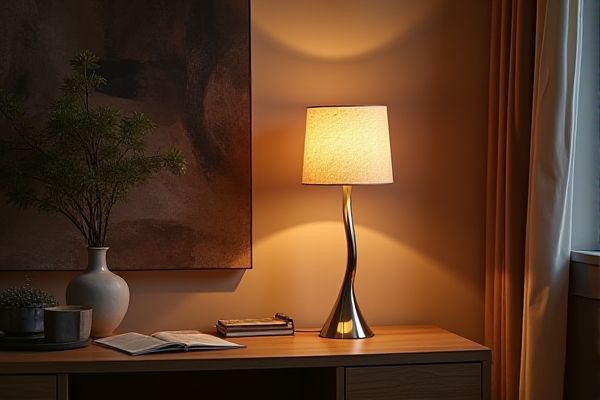
Sculptural lamps serve as artistic focal points while providing ambient or accent lighting, enhancing the aesthetic appeal of your space. Understanding the distinction between sculptural lamps and task lighting will help you choose the ideal illumination for function and style--read on to explore their unique benefits and uses.
Table of Comparison
| Feature | Sculptural Lamp | Task Lighting |
|---|---|---|
| Primary Purpose | Decorative and artistic illumination | Focused light for specific tasks |
| Design | Unique, artistic, often sculptural shapes | Functional, streamlined, practical design |
| Light Output | Ambient, soft lighting | Bright, concentrated light |
| Placement | Living rooms, galleries, accent spots | Desks, reading areas, workspaces |
| Functionality | Enhances decor, mood lighting | Improves visibility and focus |
| Typical Light Source | LED, incandescent bulbs with dimmers | LED, fluorescent, halogen with adjustable brightness |
| Energy Efficiency | Varies, often less optimized | Generally energy-efficient options available |
Introduction to Sculptural Lamps and Task Lighting
Sculptural lamps serve as artistic focal points, blending functional lighting with creative design, typically enhancing ambient atmosphere and aesthetic appeal. Task lighting specifically addresses focused illumination needs, providing bright, directed light to support activities like reading, working, or detailed crafts. While sculptural lamps emphasize form and style, task lighting prioritizes ergonomics and visual clarity to reduce eye strain and enhance productivity.
Defining Sculptural Lamps: Art Meets Illumination
Sculptural lamps blend artistic design with functional lighting, transforming your space into a gallery of light and form. Unlike task lighting, which prioritizes focused illumination for specific activities, sculptural lamps serve as statement pieces that enhance aesthetic appeal while providing ambient or accent light. Their unique shapes and materials make them not only light sources but also captivating visual art objects.
Understanding Task Lighting: Purpose and Functionality
Task lighting is designed to illuminate specific areas where activities such as reading, writing, or detailed work occur, providing focused and bright light to reduce eye strain and improve precision. Unlike sculptural lamps that primarily serve an aesthetic or decorative purpose, task lighting prioritizes functionality and practicality by offering adjustable and directed illumination. Effective task lighting includes desk lamps, under-cabinet lights, and adjustable floor lamps that enhance visibility and productivity in workspaces.
Key Differences Between Sculptural Lamps and Task Lighting
Sculptural lamps primarily serve as decorative art pieces, emphasizing aesthetic appeal and enhancing the ambiance of a room with unique shapes and materials. Task lighting, by contrast, is designed to provide focused, bright illumination that supports specific activities like reading, cooking, or working, ensuring maximum visibility and reducing eye strain. Understanding these key differences helps you choose lighting that balances style with functionality based on your needs.
Aesthetic Impact: Visual Appeal and Design Statements
Sculptural lamps serve as striking focal points, combining artistic design with ambient illumination to enhance room aesthetics. Task lighting prioritizes function, offering focused, adjustable light for activities without emphasizing decorative elements. The visual appeal of sculptural lamps creates bold design statements, while task lighting seamlessly integrates into spaces to support productivity.
Practicality: Lighting Functionality and Performance
Sculptural lamps serve as decorative art pieces that emit ambient light, enhancing aesthetic appeal but often lacking the focused illumination necessary for detailed tasks. In contrast, task lighting is designed to provide bright, directed light to improve visibility and reduce eye strain during activities like reading or working. Your choice depends on whether you prioritize artistic design or effective lighting performance for functionality.
Best Use Cases: Where Each Lighting Style Excels
Sculptural lamps excel as statement pieces in living rooms, entryways, and bedrooms, blending artistic design with ambient lighting to enhance decor while providing soft, atmospheric illumination. Task lighting performs best in workspaces, kitchens, and reading areas, delivering focused, bright light that reduces eye strain and improves productivity during detailed activities. Selecting between sculptural lamps and task lighting depends on whether the need is for aesthetic enhancement or functional illumination in a specific environment.
Choosing the Right Lighting for Your Space
Sculptural lamps serve as artistic focal points, enhancing a room's aesthetic with ambient, diffused light ideal for mood-setting and decoration. Task lighting delivers focused, bright illumination necessary for activities requiring precision, such as reading or cooking, improving functionality and reducing eye strain. Selecting the right lighting depends on balancing style and purpose, ensuring both visual appeal and adequate light levels tailored to specific tasks and spatial needs.
Energy Efficiency and Maintenance Considerations
Sculptural lamps often utilize LED technology, providing high energy efficiency while offering artistic illumination that enhances ambient spaces. Task lighting typically emphasizes function, using adjustable LEDs or fluorescents designed for targeted brightness with minimal energy consumption. Maintenance for sculptural lamps can be more complex due to intricate designs, whereas task lighting fixtures generally require simpler upkeep and easier bulb replacement.
Conclusion: Balancing Form and Function in Lighting Choices
Sculptural lamps serve as artistic focal points, enhancing aesthetic appeal while providing ambient light, whereas task lighting prioritizes functionality with focused illumination for specific activities. Balancing form and function in lighting choices involves selecting fixtures that complement interior design without compromising practical lighting needs. Optimal lighting solutions integrate sculptural elements with effective task lighting to create visually appealing, well-lit environments.
 homyna.com
homyna.com